|
Not long ago, entry into the
world of LCD front projection came with a very hefty price
tag, and picture quality was often less than awe-inspiring.
Recently however, thanks to companies like Panasonic and
Sanyo, there has been a mini-revolution in the LCD market,
with prices tumbling and picture quality soaring. My first
foray into the world of LCD front projection was with
Panasonic's
PT-AE100 a mere 16 months ago.
The
AE100 offered excellent picture quality through a set of
858x484 16:9 LCD panels at a very modest price point. Since
my original encounter Panasonic has moved two generations
beyond the AE100, and the latest addition to its stable is
the PT-AE500 (I will be reviewing the PT-AE500E, which
includes all features found on the US model, the
PT-AE500U/PT-L500U, and a 21-pin SCART RGB peritel euroconnector for the European market)
which can currently be found online for less than US$2000
from North American etailers (and less than NZ$4500 in New
Zealand).
Features found on the
PT-AE500E include:
- Three 0.7” 1280x720 LCD
panels (RGB)
- DVI-D input
- 1300:1 contrast ratio
- 5000 hour 130W UHM bulb
- Quiet 27dB fan
- Component/*SCART (21-pin
RGB)/D-SUB (15-pin RGB)/S-Video/composite inputs
- 12 volt screen trigger
- Smooth Screen technology
- Digital keystone
correction
- Digital Cinema Reality
de-interlacing
(* Not found on US model
PT-AE500U/PT-L500U)
The PT-AE500 is a High Definition model; a fact
that it displays proudly on its front fascia. The
projector's LCD panels (made by Epson) are widescreen with a
resolution of 1280x720 pixels, matching the resolution of
the 720p HD format. 1080i is accepted through the component, RGB D-SUB and DVI-D inputs, but scaled to 720p (1280x720).
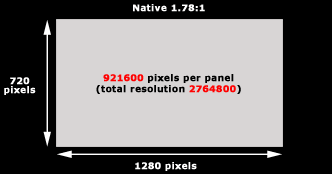
480i/p (NTSC) and 576i/p
(PAL/SECAM) signals can also be displayed, allowing users to
import PAL DVDs from Europe and Australia, for example, and
play them at their native resolution (DVD player allowing).
The AE500's inputs include the above-mentioned DVI-D input,
(PC) D-SUB RGB, RCA component inputs, S-Video and composite
in descending order of quality, although I would recommend
using only the component or DVI inputs (or RGB D-SUB for
those with HTPCs).
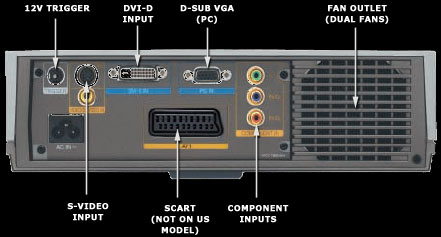
For the purposes of this
review I fed the projector's component and DVI inputs from a
Sony DVP-NS900V and Momitsu V880, respectively, using Straightwire cables and a 2 metre Audioquest DV1 DVI-D cable. All viewing
was performed in a light-controlled room with a 92”
horizontal image projected onto a finely sanded light grey
wall and black cloth matting. The projector was calibrated
with Digital Video Essentials (NTSC) and the bulb set to low power.


Upon opening the AE500's box
I was met by the projector, a thick user manual, one remote
control with batteries, a plastic carrying bag, a sturdy
detachable power cable and a three-metre length of video
cable (which quickly found itself in the closet with the
assortment of other cable refugees provided with equipment
over the years). The projector was firmly secured in the box
and wrapped in plastic and foam.
Pulled from the box, the AE500 is a light 3kg (about 6-1/2
lb) and quite small: 11 inches wide by 3 inches high by 11
inches deep. That's approximately the same width and height
as the AE100 but with about two inches of added depth. The
AE100's front panel was highly reflective plastic, but
reassuringly the AE500's front panel appears to be metal (or
at least metalised plastic) and the projector feels solid
and well built.
Initial setup was simple, the projector simply sliding into
the position previously held by the AE100 (front/table). I
was up and running in less than five minutes. Both
horizontal and vertical keystone correction are available
for those who find it necessary to place the projector at an
awkward angle to the projection surface. Unfortunately I
found that using this feature softens the picture so I
recommend avoiding it if at all possible. If you’re likely
to be installing the projector off-centre, the Sanyo PLV-Z2
may be a better choice with its lens shift feature. Luckily
I could place the projector face-on to the screen so avoided
this problem entirely.
Image focus is adjusted
using a ring around the short–throw lens (allowing an 80"
image from 2.5 metres away) and the picture may be zoomed
manually up to 1.2 times magnification. The interior lens
housing is threaded, and accepted a 55mm Marumi F-DL lens
without any problem (I could finally say goodbye to securing
the filter in place with Sellotape!). The outer lens ring is
also threaded, although exactly what size filter it will
accept I'm uncertain of; perhaps 67mm.
|
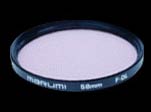
|
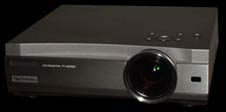 |
|
Marumi 55mm F-DL
|
AE-500 With Filter Attached |
The fan exhaust is on the rear panel, so the projector must
be given at least six inches of breathing room at the rear.
Cabinet installation appears to be out. The air filter is
easily accessed from the side of the projector and slides
down and out for easy cleaning. The projector is controlled
from five conventional buttons and a four-way arrow cursor
on the top panel of the unit, or through a small backlit
remote control, which I found had a very good range. The
main power button is located on the right-hand side of the
projector (unlike the AE100, causing a few moments of
confusion… erm, for a friend :) )
After spending a few minutes
calibrating the image with Digital Video Essentials
(NTSC) I
settled down with a nice chilled bottle of RC Cola for some
serious viewing. As always the sheer scale of the image was
the first thing that struck me; nothing can match a truly
huge image for home theatre tingles down your spine. Right
off the bat I noticed an absence of visible pixel structure
(the notorious 'screen door' effect, something that the
AE100 was notably affected by) and it's clear that Panasonic
has made enormous strides in this area using the 'Smooth
Screen' prism system. If you're at all worried about the LCD curse
of viewing your movies through 'chicken wire', don't be.
Screen door is not a problem here, even when viewing from a
distance of 1 x screen width (although my final viewing
position was at a distance of 1.3 times screen width).
The projector's contrast ratio of up to 1300:1 was also
immediately evident, and although blacks are still short of
truly black, shadow detail is more than sufficient to
provide a very pleasing picture. The AE500 includes an 'AI'
mode that modulates lamp brightness according to the average
light output of the projected image, but the improvement in
contrast this feature provides was subtle and I preferred
the black level (and the knowledge that lamp life was
potentially more than doubled) with AI turned off and bulb
output set to low. Colours are outstanding:
vibrant and natural looking. But a word of caution, if the
colour level is set too high images can easily take on a
fluorescent appearance. Overall, the picture produced was
outstanding, with a very smooth, razor-sharp image. As with
all LCD projectors, geometry was perfect: one of the great
advantages of this technology. Watching the R4
anamorphically-enhanced DVD of True Lies the opening
title's edges were flat as a ruler, something I've never
seen on a CRT television. Switching to X2 (R1 NTSC), Blade
(R1 NTSC),
Star Wars: Episode 2 (R4 PAL) and Finding Nemo (R1
NTSC) among
others, the picture was often breathtaking. More than once I
found myself caught up by the movie rather than tracking the
projector: always a good sign.
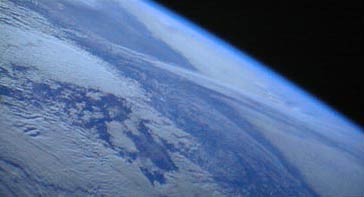
Digital Video Essentials (NTSC projected at 92")
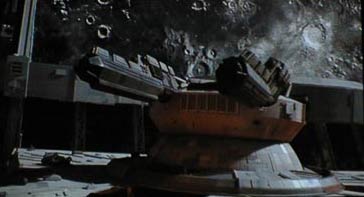
Starship
Troopers: Superbit (R1 NTSC projected at 92")
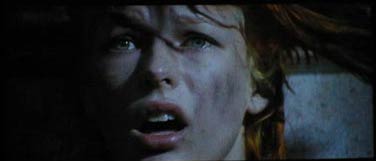
The Fifth
Element: Superbit (R1 NTSC projected at 92")
Rated at a medium 850 ANSI
lumens, the AE500 was more than bright enough in a light
controlled room, and the picture was still perfectly
viewable (if washed out) with dimmed artificial lighting. I
viewed the projector with the bulb set to 'low' as this
improved the black level, but many may prefer the brighter
image of the 'high' setting. Bear in mind that bulb life
will be reduced to a maximum of 2000 hours at this setting,
though. In its low power setting the bulb will last up to an
amazing 5000 hours: that's the equivalent of watching two
movies a day every day for over four and a half years!
The fan is worthy of special note as it is impressively
quiet. From three feet away I could barely hear it
functioning when playing a movie at normal listening levels.
It is pitched much lower than the fan on the AE100, making it
altogether less intrusive.
Like all LCD projectors, the
AE500 de-interlaces all incoming interlaced video. The
quality of this de-interlacing, using the 'Digital Cinema
Reality' system, is very good and a notable step up from the
AE100. Using a non-progressive source, only occasionally did
scan-lines become visible, and the picture was very smooth
and generally free of stair stepping. Only once did the
projector seem to trip up, playing Star Trek Nemesis
(R1). It appeared to drop permanently into video mode,
producing a noticeably soft image. Generally speaking, if
you don't own a progressive scan DVD player, you aren’t
losing much with this projector. Switching between
progressive and interlaced outputs, I was unable to detect
any significant difference (in fact, any at all most of the
time).
Now for the downside. The AE100 produced some mild ringing
(appearing like horizontal and vertical edge enhancement) when fed through its
component video inputs, and while this is reduced with the AE500
it can still be seen; this effect is eliminated by using the DVI or D-SUB inputs, however (I didn't have a SCART cable
handy so couldn't check this connection). Mild vertical
banding (narrow vertical bands of alternating
brightness) could also be seen sporadically in low-light
grey or off-white scenes. This banding was visible when
using all connections, including the DVI and RGB inputs.
Accessing the service menu (by pressing 'Menu', selecting
'Option', then 'OSD' and hold down the 'enter' key on the
remote control) and adjusting the voltage fed to each panel
with the Flicker option significantly reduced this problem,
however. There is also some mild fixed panel noise, but this
appears to be a problem common to all LCD projectors
and never became more than minor a distraction.
Like the AE100, the AE500's
de-interlacing is also a little less sure-footed when being
fed PAL software, and seems to randomly switch between
de-interlacing modes when dealing with interlaced PAL (this
is best illustrated with films' closing credits, but isn't
noticeable during normal movie viewing). This may be a
result of the incorrect flagging of many film-based PAL DVDs
as video.
For those in PAL-land, I wouldn't use this projector without
a decent progressive scan DVD player that doesn't rely on
flags (try
www.hometheaterhifi.com, the gold standard for
progressive scan DVD player reviews).
Switching from component to
the DVI input, picture quality improves significantly. This
digital connection allows the projector to show its true
colours. Sharpness, contrast and colour are all improved
(the latter most dramatically). Using DVI, the ringing of
the component video connection vanishes and the image seems
'smoother' and more natural. Short of a truly digital
connection (such as DLP) this is the shortest chain from the
DVD to the screen.
DVI/HDMI-equipped players are now available from Marantz,
Pioneer, Denon, Samsung, LG and others (HDMI players can be
connected using an HDMI to DVI adapter cable) as well as DVI
video cards for those equipped with HTPCs (But note that the
AE500's DVI port is DVI-D only, so check the compatibility
of your video cables: the analogue pins on a standard DVI-I
cable will prevent it from plugging into the AE500). Anyone
wanting to get the most from their AE500 should undoubtedly
be using the DVI input. As the DVI input is HDCP compatible,
it should also stand you in good stead for the rapidly
approaching optical high definition formats.
Using Momitsu's V880 DVD player to scale (NTSC) DVD's
native 480i image to 720p caused no problems and the
projector happily recognised the incoming 720p signal
(calling it '750P' for some unknown reason rather than the
expected '720P'). The images I got with the combination of
the Momitsu and AE500 using DVI were nothing short of
outstanding. Using a custom resolution to match the AE500
improved picture quality another step by eliminating the
need for scaling within the projector and is highly
recommended (the steps needed for 1:1 mapping of the V880
and AE500 are listed at the bottom of the page).

(Click for Large View)
The projector's user
adjustments include the usual sharpness, colour (not
available when using DVI), tint, brightness, contrast and
colour temperature controls but unusually also include three
gamma levels and individual control over red, green and blue
brightness and contrast levels. Once adjusted, up to three
custom settings can be stored in the projector's memory (for
each input), and the remote allows direct one-touch access
to these memory settings. Nice! Speaking of the remote,
although it's a small unit an indent allowed it to sit very
comfortably in my hand and all buttons could be reached with
one thumb; this remote is a big step up from the credit card
remotes or yore (and hopefully I will now no longer be
constantly losing the remote down the side of my chair!).
Video input, keystone correction, video aspect ratio,
picture mode and user video memory are all directly
accessible from the remote, with internal functions using a
traditional menu button and arrow keys.
The AE500 is a tremendous
improvement over the AE100, with an outstanding feature
set and groundbreaking picture quality. As with all other
LCD projectors, black level isn’t perfect, but the AE500's
contrast level is currently cutting edge at its price and
very good indeed for an LCD. Overall picture quality is
excellent and the image thrown on the wall very cinematic.
For the price this is an
indisputable bargain. If you're in the market for a front
projector around the US$2000 mark (or even a conventional
RPTV) then you should definitely take a cruise down to your
local retailer to investigate the AE500.
|
 Download PT-AE500
Manual (ZIP/PDF/936 KB) |
Download PT-AE500
Manual (ZIP/PDF/936 KB) | |